United States. Olive oil imports, trends
Over the years, structural changes have been observed in the import market. Spain currently dominates the bulk market and is gaining volume in the bottled container sector. For the second year in a row, Spain is the first supplier to the US in terms of volume

The United States, which is the first global importer of olive oil, closed its olive oil imports for the 2016/17 crop year at 316 758 t, which is a 4% decrease on last year. This however follows on from a record 2015/16 crop year, registering a total of 331 368 t. Graph I shows the steady growth in US imports over the last 25 crop years.
Two decades ago, imports of olive oil in the United States accounted for approximately 30% of global imports, whereas they currently account for 38%. Over the years, structural changes have been observed in the import market, as illustrated in Graph II, which tracks imports by container type. In 1995/96 imports in containers of


Table 1 shows the breakdown of imports by country of origin and container type over the last crop year. Over this period, bulk containers increased by 13.2% and bottled oils increased by 1.5%. The five main suppliers of olive oil in bottled containers are Italy, followed by Spain, Greece, Tunisia and Turkey, while the bulk container market is led by Spain, followed by Tunisia, Argentina, Turkey and Chile.

Spain currently dominates the bulk market and is gaining volume in the bottled container sector. For the second year in a row, Spain is the first supplier to the US in terms of volume. Note should also be taken of the bulk volumes sold by Tunisia, Argentina and Turkey, and the strong increase in the sale of containers >18 kg by Argentina, Turkey and Chile.

Graph III shows the trends in imports per quality type. In the 2016/2017 crop year, 52% of total imports were of the extra virgin olive oil category, decreasing by 11% compared to the previous year. This was followed by imports of olive oil, which accounted for 24% of the total and posted a 28% decrease. Olive- pomace oil at 4% decreased by 30%, followed by the categories of virgin olive oil and organic virgin olive oil with smaller volumes.
Photo by Luigi Caricato
To comment you have to register
If you're already registered you can click here to access your account
or click here to create a new account


Comment this news